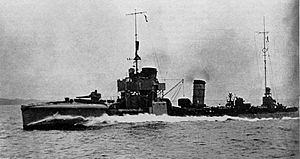SMS S35 (1914) facts for kids

SMS S56 was the sister ship of SMS S35
|
|
Quick facts for kids History |
|
|---|---|
| Name | S35 |
| Ordered | 1913 |
| Builder | Schichau-Werke, Elbing |
| Launched | 30 August 1914 |
| Commissioned | 4 December 1914 |
| Fate | Sunk at Battle of Jutland 31 May 1916 |
| General characteristics | |
| Displacement | 971 tonnes (956 long tons) |
| Length | 79.6 m (261 ft 2 in) |
| Beam | 8.3 m (27 ft 3 in) |
| Draft | 2.8 m (9 ft 2 in) |
| Installed power | 23,500 shp (17,500 kW) |
| Propulsion |
|
| Speed | 33.5 knots (62.0 km/h; 38.6 mph) |
| Range | 1,100 nmi (2,000 km; 1,300 mi) at 20 knots (37 km/h; 23 mph) |
| Complement | 83 officers and sailors |
| Armament |
|
SMS S35 was a special type of fast warship called a Large Torpedo Boat. The letters "SMS" stood for "Seiner Majestät Schiff", which means "His Majesty's Ship" in German. This ship was part of the Imperial German Navy during World War I. S35 was involved in the big Battle of Jutland where it was sunk by British battleships.
Contents
Building the S35
Ordering New Torpedo Boats
In 1913, the German Navy decided to order 12 new, powerful torpedo boats. These ships were much bigger and better than the smaller ones they had built before. Six of these boats, including S35, were ordered from a company called Schichau-Werke.
Launch and Commission
While S35 was still being built, it was actually sold to Greece in June 1914. However, when World War I started, Germany took the ship back on August 10, 1914. S35 was officially launched into the water on August 30, 1914. It was ready for duty and joined the navy on December 4, 1914.
Ship's Size and Power
The S35 was about 79.6 meters (261 feet) long. It was 8.3 meters (27 feet) wide and went 2.8 meters (9 feet) deep into the water. The ship weighed about 971 tons when fully loaded.
To make it move, S35 had three special boilers that made steam. This steam powered two large steam turbines, which could create a lot of power. This allowed the ship to travel very fast, up to 33.5 knots (about 62 kilometers per hour or 38.5 miles per hour). It could travel about 1,100 nautical miles (2,000 kilometers or 1,300 miles) at a speed of 20 knots.
Weapons on Board
The S35 was armed with three 8.8 cm (3.5 inch) guns. It also had six 50 cm (19.7 inch) torpedo tubes. Torpedoes are like underwater missiles. Two of these tubes were fixed at the front, and two sets of two tubes were at the back. The ship could also carry up to 24 mines, which are explosives placed in the water to damage enemy ships. There were 83 officers and sailors on board to operate the ship.
S35's Time in Service
Battle of Dogger Bank (1915)
On January 23, 1915, S35 was part of a German fleet that went to attack British fishing boats. This fleet was led by Admiral Franz von Hipper. British spies, who had decoded German radio messages, knew about the attack. They sent out their own powerful ships to stop the Germans.
The two sides met on January 24 in the Battle of Dogger Bank. When the Germans saw the British ships, they tried to escape. One German ship, the armored cruiser Blücher, was hit and sunk. The rest of the German ships got away, but some were badly damaged. S35 helped escort the German fleet during this battle.
Gulf of Riga Battle (1915)
S35 also took part in the Battle of the Gulf of Riga in August 1915. During this battle, another German torpedo boat, S31, hit a mine and sank. Boats from S35 and another ship helped rescue the crew of S31.
Battle of Jutland (1916)
S35 was involved in the Bombardment of Yarmouth and Lowestoft in April 1916. But its most famous action was at the Battle of Jutland on May 31, 1916. This was one of the biggest naval battles in history.
First Torpedo Attack
S35 was part of a group of torpedo boats supporting larger German ships. Around 5:26 PM, S35 and its group tried to launch a torpedo attack on British battlecruisers. British destroyers fought back, and one German torpedo boat, V29, was hit by a British torpedo. S35 and another ship, V26, bravely rescued the crew of V29 before it sank. Another German ship, V27, was damaged by British shells and had to be sunk by its own side.
Final Attack and Sinking
Later that day, around 8:15 PM, S35 joined a large torpedo attack. This attack was meant to help the German battleships turn away from the British fleet. The German torpedo boats came under heavy fire from British battleships.
S35 fired two torpedoes at the British ships. However, it was hit by two large shells, likely from the British battleship Iron Duke. The hits were so powerful that S35 broke in half and sank. All 88 people on board, including the survivors from V29 that S35 had rescued, were lost. None of the torpedoes fired by the Germans hit their targets, but they did force some British battleships to move out of the way.

